MITSUBISHI ASX 2018 Owner's Manual (in English)
Manufacturer: MITSUBISHI, Model Year: 2018, Model line: ASX, Model: MITSUBISHI ASX 2018Pages: 514, PDF Size: 34.89 MB
Page 191 of 514
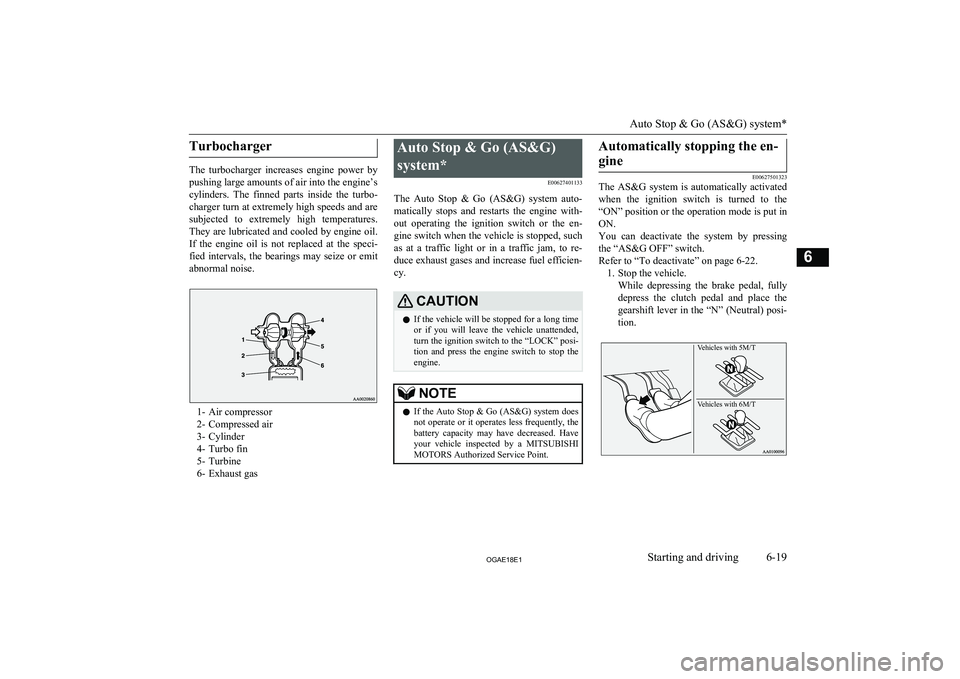
Turbocharger
The turbocharger increases engine power by
pushing large amounts of air into the engine’s
cylinders. The finned parts inside the turbo-
charger turn at extremely high speeds and are subjected to extremely high temperatures. They are lubricated and cooled by engine oil.
If the engine oil is not replaced at the speci-
fied intervals, the bearings may seize or emit abnormal noise.
1- Air compressor
2- Compressed air
3- Cylinder
4- Turbo fin
5- Turbine
6- Exhaust gas
Auto Stop & Go (AS&G)
system* E00627401133
The Auto Stop & Go (AS&G) system auto- matically stops and restarts the engine with- out operating the ignition switch or the en-gine switch when the vehicle is stopped, such
as at a traffic light or in a traffic jam, to re- duce exhaust gases and increase fuel efficien- cy.CAUTIONl If the vehicle will be stopped for a long time
or if you will leave the vehicle unattended,
turn the ignition switch to the “LOCK” posi-
tion and press the engine switch to stop the
engine.NOTEl If the Auto Stop & Go (AS&G) system does
not operate or it operates less frequently, the battery capacity may have decreased. Have
your vehicle inspected by a MITSUBISHI
MOTORS Authorized Service Point.Automatically stopping the en-
gine
E00627501323
The AS&G system is automatically activated
when the ignition switch is turned to the
“ON” position or the operation mode is put in
ON.
You can deactivate the system by pressing the “AS&G OFF” switch.
Refer to “To deactivate” on page 6-22. 1. Stop the vehicle.
While depressing the brake pedal, fullydepress the clutch pedal and place the gearshift lever in the “N” (Neutral) posi-
tion.
Vehicles with 5M/T Vehicles with 6M/T
Auto Stop & Go (AS&G) system*
6-19OGAE18E1Starting and driving6
Page 192 of 514
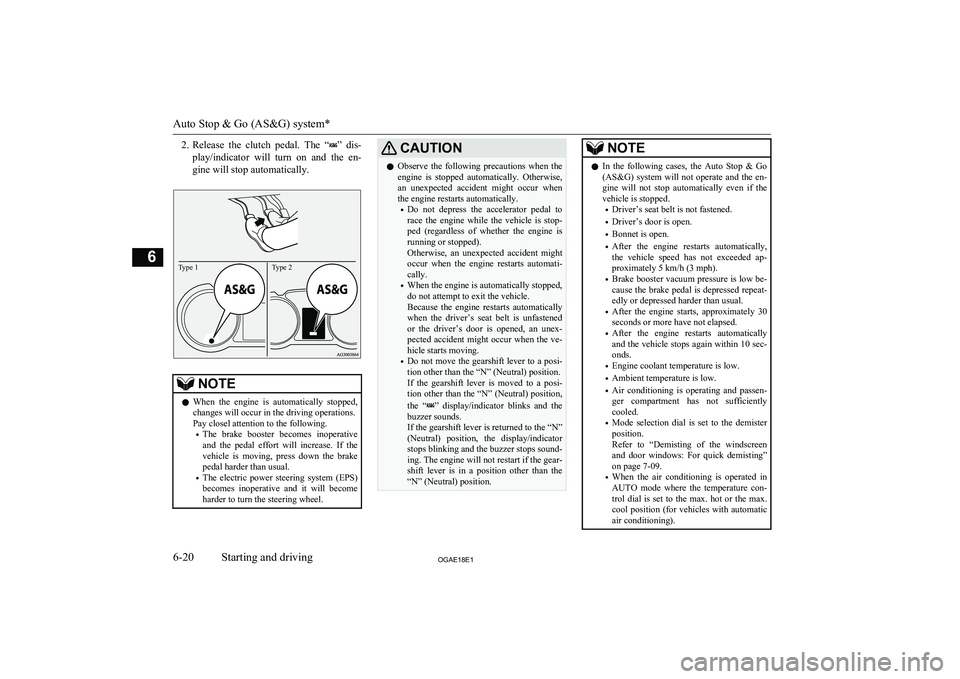
2.Release the clutch pedal. The “” dis-
play/indicator will turn on and the en- gine will stop automatically.Type 1Type 2
NOTEl When the engine is automatically stopped,
changes will occur in the driving operations.
Pay closel attention to the following.
• The brake booster becomes inoperative
and the pedal effort will increase. If the
vehicle is moving, press down the brake pedal harder than usual.
• The electric power steering system (EPS)
becomes inoperative and it will become
harder to turn the steering wheel.CAUTIONl Observe the following precautions when the
engine is stopped automatically. Otherwise,
an unexpected accident might occur when the engine restarts automatically.
• Do not depress the accelerator pedal to
race the engine while the vehicle is stop-
ped (regardless of whether the engine is running or stopped).
Otherwise, an unexpected accident might
occur when the engine restarts automati- cally.
• When the engine is automatically stopped,
do not attempt to exit the vehicle.
Because the engine restarts automatically when the driver’s seat belt is unfastened
or the driver’s door is opened, an unex- pected accident might occur when the ve-
hicle starts moving.
• Do not move the gearshift lever to a posi-
tion other than the “N” (Neutral) position.
If the gearshift lever is moved to a posi-
tion other than the “N” (Neutral) position,
the “
” display/indicator blinks and the
buzzer sounds.
If the gearshift lever is returned to the “N”
(Neutral) position, the display/indicator
stops blinking and the buzzer stops sound- ing. The engine will not restart if the gear-
shift lever is in a position other than the “N” (Neutral) position.
NOTEl In the following cases, the Auto Stop & Go
(AS&G) system will not operate and the en- gine will not stop automatically even if thevehicle is stopped.
• Driver’s seat belt is not fastened.
• Driver’s door is open.
• Bonnet is open.
• After the engine restarts automatically,
the vehicle speed has not exceeded ap-
proximately 5 km/h (3 mph).
• Brake booster vacuum pressure is low be-
cause the brake pedal is depressed repeat- edly or depressed harder than usual.
• After the engine starts, approximately 30
seconds or more have not elapsed.
• After the engine restarts automatically
and the vehicle stops again within 10 sec-onds.
• Engine coolant temperature is low.
• Ambient temperature is low.
• Air conditioning is operating and passen-
ger compartment has not sufficiently
cooled.
• Mode selection dial is set to the demister
position.
Refer to “Demisting of the windscreen
and door windows: For quick demisting”
on page 7-09.
• When the air conditioning is operated in
AUTO mode where the temperature con- trol dial is set to the max. hot or the max.
cool position (for vehicles with automatic
air conditioning).
Auto Stop & Go (AS&G) system*
6-20OGAE18E1Starting and driving6
Page 193 of 514
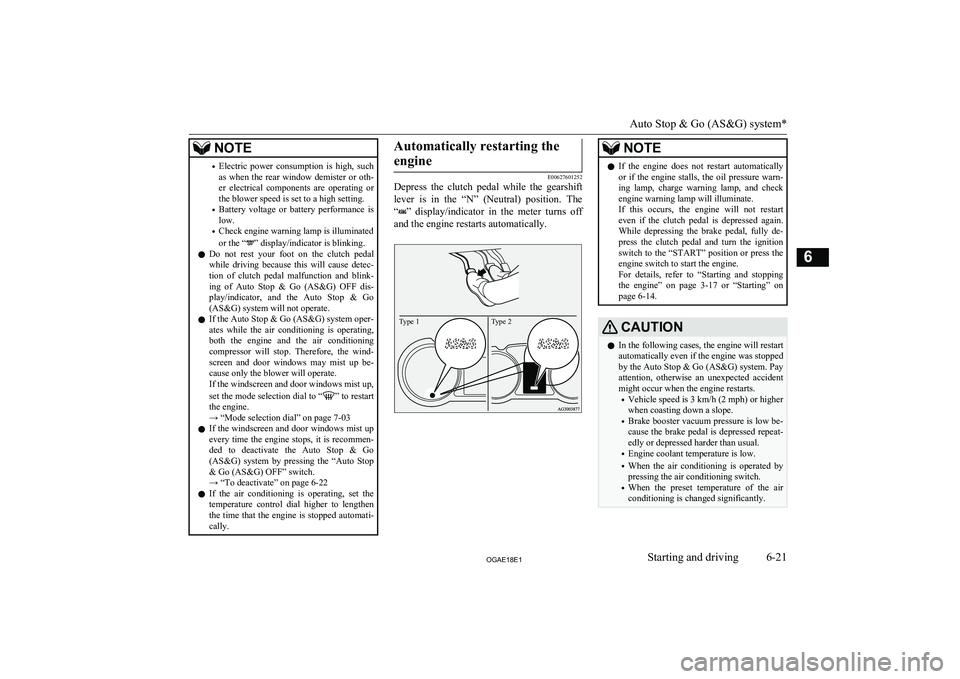
NOTE•Electric power consumption is high, such
as when the rear window demister or oth-
er electrical components are operating or
the blower speed is set to a high setting.
• Battery voltage or battery performance is
low.
• Check engine warning lamp is illuminated
or the “
” display/indicator is blinking.
l Do not rest your foot on the clutch pedal
while driving because this will cause detec-
tion of clutch pedal malfunction and blink-
ing of Auto Stop & Go (AS&G) OFF dis- play/indicator, and the Auto Stop & Go
(AS&G) system will not operate.
l If the Auto Stop & Go (AS&G) system oper-
ates while the air conditioning is operating,
both the engine and the air conditioning
compressor will stop. Therefore, the wind- screen and door windows may mist up be-
cause only the blower will operate.
If the windscreen and door windows mist up,
set the mode selection dial to “
” to restart
the engine.
→ “Mode selection dial” on page 7-03
l If the windscreen and door windows mist up
every time the engine stops, it is recommen-
ded to deactivate the Auto Stop & Go
(AS&G) system by pressing the “Auto Stop & Go (AS&G) OFF” switch.
→ “To deactivate” on page 6-22
l If the air conditioning is operating, set the
temperature control dial higher to lengthen
the time that the engine is stopped automati- cally.
Automatically restarting the
engine
E00627601252
Depress the clutch pedal while the gearshift
lever is in the “N” (Neutral) position. The
“
” display/indicator in the meter turns off
and the engine restarts automatically.
Type 2Type 1
NOTEl If the engine does not restart automatically
or if the engine stalls, the oil pressure warn- ing lamp, charge warning lamp, and check
engine warning lamp will illuminate.
If this occurs, the engine will not restart even if the clutch pedal is depressed again. While depressing the brake pedal, fully de-
press the clutch pedal and turn the ignition switch to the “START” position or press the
engine switch to start the engine.
For details, refer to “Starting and stopping the engine” on page 3-17 or “Starting” on
page 6-14.CAUTIONl In the following cases, the engine will restart
automatically even if the engine was stopped
by the Auto Stop & Go (AS&G) system. Pay attention, otherwise an unexpected accidentmight occur when the engine restarts.
• Vehicle speed is 3 km/h (2 mph) or higher
when coasting down a slope.
• Brake booster vacuum pressure is low be-
cause the brake pedal is depressed repeat- edly or depressed harder than usual.
• Engine coolant temperature is low.
• When the air conditioning is operated by
pressing the air conditioning switch.
• When the preset temperature of the air
conditioning is changed significantly.
Auto Stop & Go (AS&G) system*
6-21OGAE18E1Starting and driving6
Page 194 of 514
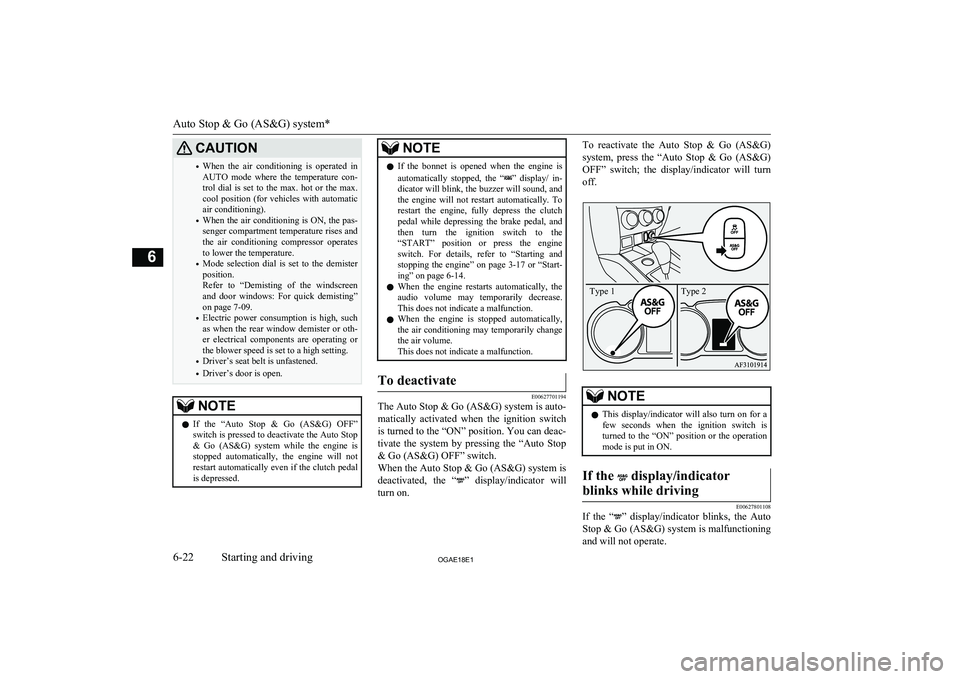
CAUTION•When the air conditioning is operated in
AUTO mode where the temperature con- trol dial is set to the max. hot or the max.
cool position (for vehicles with automatic air conditioning).
• When the air conditioning is ON, the pas-
senger compartment temperature rises and
the air conditioning compressor operates to lower the temperature.
• Mode selection dial is set to the demister
position.
Refer to “Demisting of the windscreen and door windows: For quick demisting”
on page 7-09.
• Electric power consumption is high, such
as when the rear window demister or oth- er electrical components are operating or
the blower speed is set to a high setting.
• Driver’s seat belt is unfastened.
• Driver’s door is open.NOTEl If the “Auto Stop & Go (AS&G) OFF”
switch is pressed to deactivate the Auto Stop
& Go (AS&G) system while the engine is
stopped automatically, the engine will not restart automatically even if the clutch pedal
is depressed.NOTEl If the bonnet is opened when the engine is
automatically stopped, the “” display/ in-
dicator will blink, the buzzer will sound, and the engine will not restart automatically. To
restart the engine, fully depress the clutch pedal while depressing the brake pedal, andthen turn the ignition switch to the“START” position or press the engine
switch. For details, refer to “Starting and stopping the engine” on page 3-17 or “Start-
ing” on page 6-14.
l When the engine restarts automatically, the
audio volume may temporarily decrease.
This does not indicate a malfunction.
l When the engine is stopped automatically,
the air conditioning may temporarily change the air volume.
This does not indicate a malfunction.To deactivate
E00627701194
The Auto Stop & Go (AS&G) system is auto-
matically activated when the ignition switch
is turned to the “ON” position. You can deac-
tivate the system by pressing the “Auto Stop & Go (AS&G) OFF” switch.
When the Auto Stop & Go (AS&G) system is deactivated, the “
” display/indicator will
turn on.
To reactivate the Auto Stop & Go (AS&G)
system, press the “Auto Stop & Go (AS&G)
OFF” switch; the display/indicator will turn
off.NOTEl This display/indicator will also turn on for a
few seconds when the ignition switch isturned to the “ON” position or the operationmode is put in ON.If the display/indicator
blinks while driving
E00627801108
If the “” display/indicator blinks, the Auto
Stop & Go (AS&G) system is malfunctioning
and will not operate.
Auto Stop & Go (AS&G) system*
6-22OGAE18E1Starting and driving6 Type 1 Type 2
Page 195 of 514
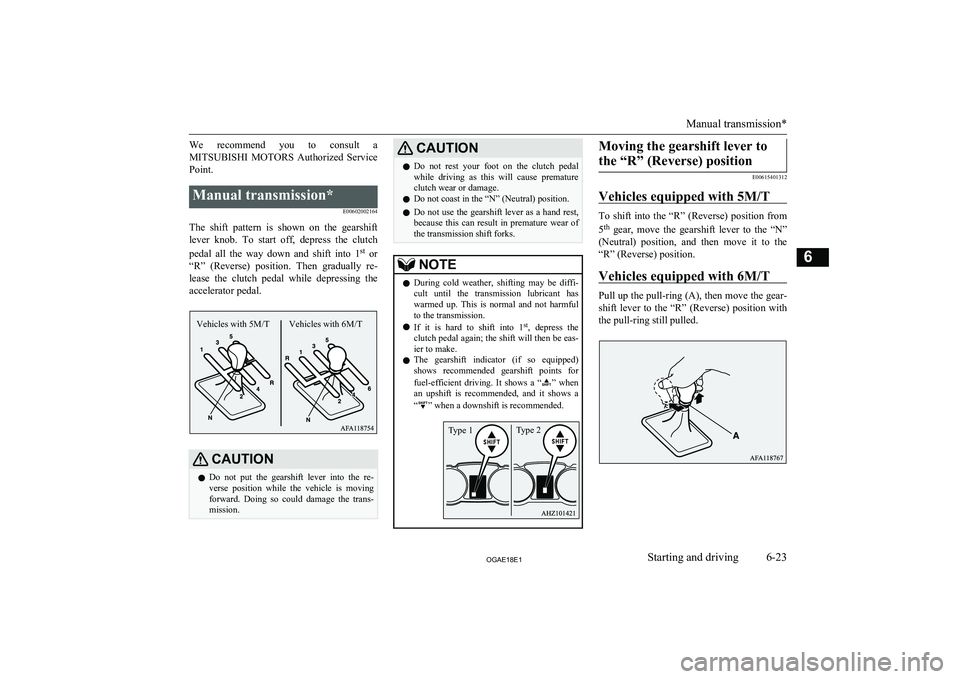
We recommend you to consult aMITSUBISHI MOTORS Authorized Service
Point.Manual transmission*
E00602002164
The shift pattern is shown on the gearshiftlever knob. To start off, depress the clutch
pedal all the way down and shift into 1 st
or
“R” (Reverse) position. Then gradually re- lease the clutch pedal while depressing the
accelerator pedal.
CAUTIONl Do not put the gearshift lever into the re-
verse position while the vehicle is moving forward. Doing so could damage the trans-mission.CAUTIONl Do not rest your foot on the clutch pedal
while driving as this will cause premature
clutch wear or damage.
l Do not coast in the “N” (Neutral) position.
l Do not use the gearshift lever as a hand rest,
because this can result in premature wear of
the transmission shift forks.NOTEl During cold weather, shifting may be diffi-
cult until the transmission lubricant has
warmed up. This is normal and not harmful
to the transmission.
l If it is hard to shift into 1 st
, depress the
clutch pedal again; the shift will then be eas-
ier to make.
l The gearshift indicator (if so equipped)
shows recommended gearshift points for
fuel-efficient driving. It shows a “
” when
an upshift is recommended, and it shows a
“
” when a downshift is recommended.
Moving the gearshift lever to
the “R” (Reverse) position
E00615401312
Vehicles equipped with 5M/T
To shift into the “R” (Reverse) position from
5 th
gear, move the gearshift lever to the “N”
(Neutral) position, and then move it to the “R” (Reverse) position.
Vehicles equipped with 6M/T
Pull up the pull-ring (A), then move the gear-
shift lever to the “R” (Reverse) position with the pull-ring still pulled.
Manual transmission*
6-23OGAE18E1Starting and driving6Vehicles with 5M/T Vehicles with 6M/T Type 1Type 2
Page 196 of 514
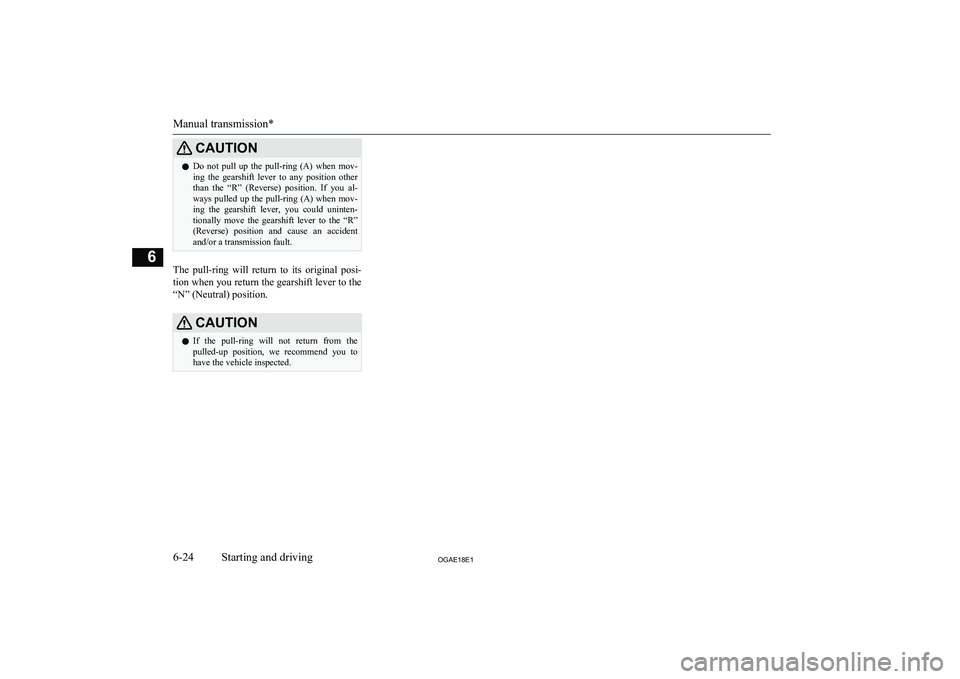
CAUTIONlDo not pull up the pull-ring (A) when mov-
ing the gearshift lever to any position other than the “R” (Reverse) position. If you al-
ways pulled up the pull-ring (A) when mov- ing the gearshift lever, you could uninten- tionally move the gearshift lever to the “R”
(Reverse) position and cause an accident and/or a transmission fault.
The pull-ring will return to its original posi-
tion when you return the gearshift lever to the“N” (Neutral) position.
CAUTIONl If the pull-ring will not return from the
pulled-up position, we recommend you to
have the vehicle inspected.
Manual transmission*
6-24OGAE18E1Starting and driving6
Page 197 of 514
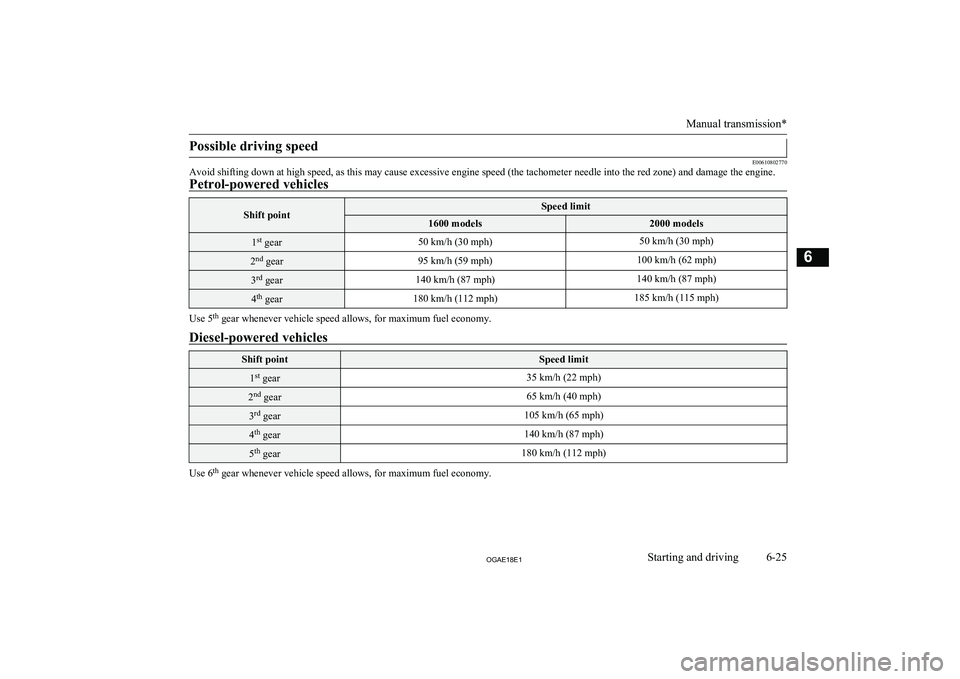
Possible driving speed
E00610802770
Avoid shifting down at high speed, as this may cause excessive engine speed (the tachometer needle into the red zone) and damage the engine.
Petrol-powered vehiclesShift pointSpeed limit1600 models2000 models1 st
gear50 km/h (30 mph)50 km/h (30 mph)2nd
gear95 km/h (59 mph)100 km/h (62 mph)3rd
gear140 km/h (87 mph)140 km/h (87 mph)4th
gear180 km/h (112 mph)185 km/h (115 mph)
Use 5 th
gear whenever vehicle speed allows, for maximum fuel economy.
Diesel-powered vehiclesShift pointSpeed limit1st
gear35 km/h (22 mph)2nd
gear65 km/h (40 mph)3rd
gear105 km/h (65 mph)4th
gear140 km/h (87 mph)5th
gear180 km/h (112 mph)
Use 6 th
gear whenever vehicle speed allows, for maximum fuel economy.
Manual transmission*
6-25OGAE18E1Starting and driving6
Page 198 of 514
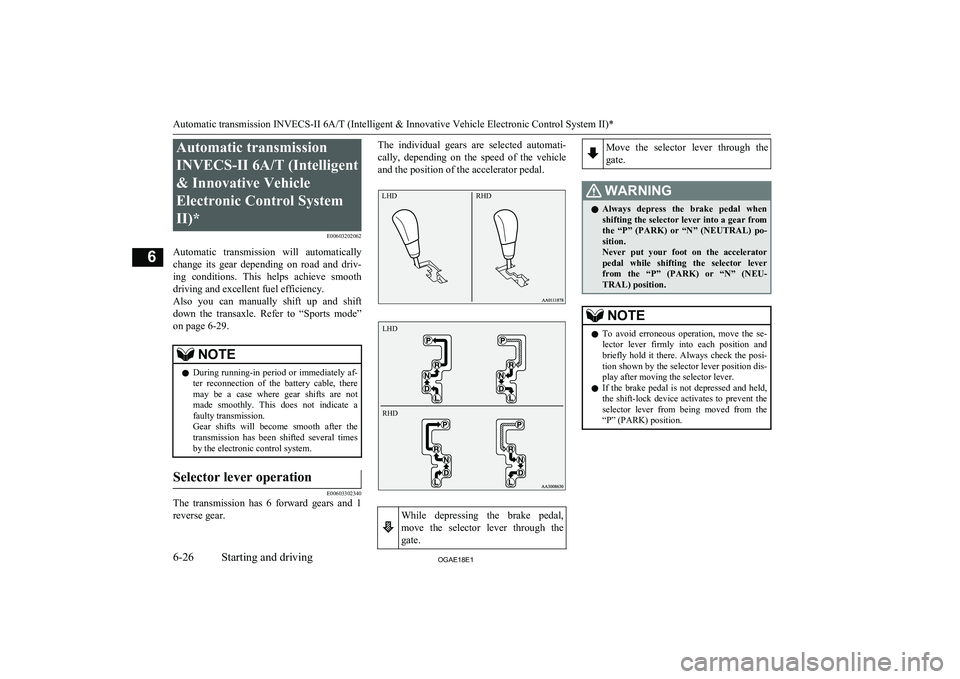
Automatic transmissionINVECS-II 6A/T (Intelligent& Innovative Vehicle
Electronic Control System
II)* E00603202062
Automatic transmission will automatically
change its gear depending on road and driv- ing conditions. This helps achieve smooth
driving and excellent fuel efficiency.
Also you can manually shift up and shift down the transaxle. Refer to “Sports mode”
on page 6-29.NOTEl During running-in period or immediately af-
ter reconnection of the battery cable, there may be a case where gear shifts are not
made smoothly. This does not indicate a faulty transmission.
Gear shifts will become smooth after the transmission has been shifted several times
by the electronic control system.Selector lever operation
E00603302340
The transmission has 6 forward gears and 1
reverse gear.
The individual gears are selected automati-cally, depending on the speed of the vehicle
and the position of the accelerator pedal.LHDRHDLHDRHDWhile depressing the brake pedal,
move the selector lever through the gate.Move the selector lever through the
gate.WARNINGl Always depress the brake pedal when
shifting the selector lever into a gear from the “P” (PARK) or “N” (NEUTRAL) po-sition.
Never put your foot on the accelerator
pedal while shifting the selector lever
from the “P” (PARK) or “N” (NEU- TRAL) position.NOTEl To avoid erroneous operation, move the se-
lector lever firmly into each position and
briefly hold it there. Always check the posi- tion shown by the selector lever position dis-
play after moving the selector lever.
l If the brake pedal is not depressed and held,
the shift-lock device activates to prevent the selector lever from being moved from the “P” (PARK) position.
Automatic transmission INVECS-II 6A/T (Intelligent & Innovative Vehicle Electronic Control System II)*
6-26OGAE18E1Starting and driving6
Page 199 of 514
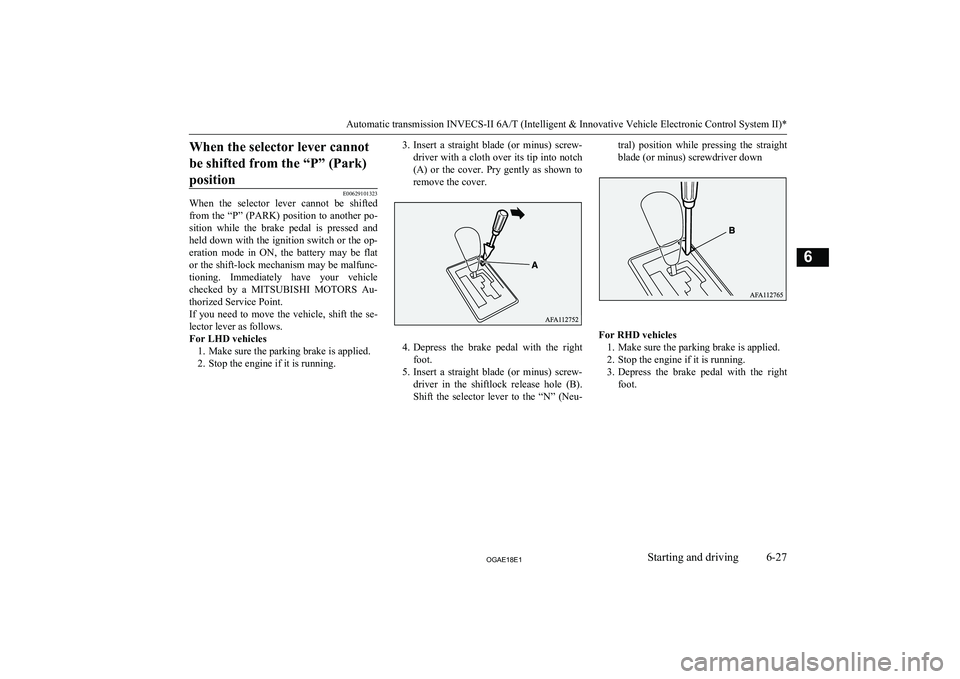
When the selector lever cannotbe shifted from the “P” (Park)position
E00629101323
When the selector lever cannot be shifted
from the “P” (PARK) position to another po-
sition while the brake pedal is pressed and
held down with the ignition switch or the op- eration mode in ON, the battery may be flator the shift-lock mechanism may be malfunc-
tioning. Immediately have your vehicle checked by a MITSUBISHI MOTORS Au-
thorized Service Point.
If you need to move the vehicle, shift the se- lector lever as follows.
For LHD vehicles 1. Make sure the parking brake is applied.
2. Stop the engine if it is running.
3. Insert a straight blade (or minus) screw-
driver with a cloth over its tip into notch
(A) or the cover. Pry gently as shown to remove the cover.
4. Depress the brake pedal with the right
foot.
5. Insert a straight blade (or minus) screw-
driver in the shiftlock release hole (B).Shift the selector lever to the “N” (Neu-
tral) position while pressing the straight
blade (or minus) screwdriver down
For RHD vehicles 1. Make sure the parking brake is applied.
2. Stop the engine if it is running.
3. Depress the brake pedal with the right
foot.
Automatic transmission INVECS-II 6A/T (Intelligent & Innovative Vehicle Electronic Control System II)*
6-27OGAE18E1Starting and driving6
Page 200 of 514
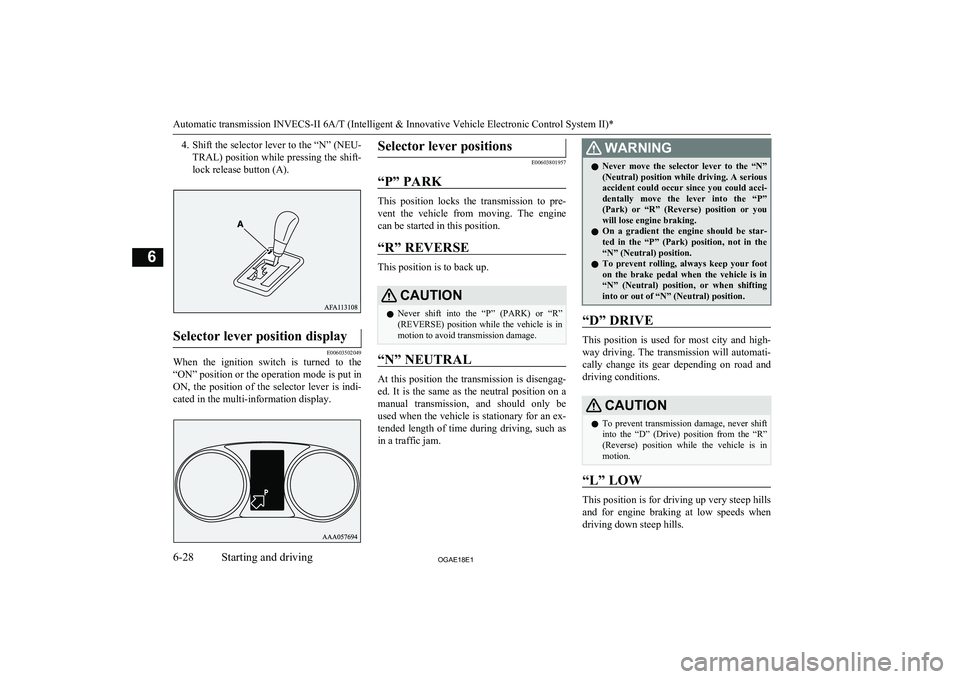
4.Shift the selector lever to the “N” (NEU-
TRAL) position while pressing the shift- lock release button (A).Selector lever position display
E00603502049
When the ignition switch is turned to the
“ON” position or the operation mode is put in ON, the position of the selector lever is indi-
cated in the multi-information display.
Selector lever positions
E00603801957
“P” PARK
This position locks the transmission to pre- vent the vehicle from moving. The engine
can be started in this position.
“R” REVERSE
This position is to back up.
CAUTIONl Never shift into the “P” (PARK) or “R”
(REVERSE) position while the vehicle is in motion to avoid transmission damage.
“N” NEUTRAL
At this position the transmission is disengag-
ed. It is the same as the neutral position on amanual transmission, and should only be used when the vehicle is stationary for an ex-
tended length of time during driving, such as
in a traffic jam.
WARNINGl Never move the selector lever to the “N”
(Neutral) position while driving. A seriousaccident could occur since you could acci-dentally move the lever into the “P”(Park) or “R” (Reverse) position or you
will lose engine braking.
l On a gradient the engine should be star-
ted in the “P” (Park) position, not in the
“N” (Neutral) position.
l To prevent rolling, always keep your foot
on the brake pedal when the vehicle is in
“N” (Neutral) position, or when shifting into or out of “N” (Neutral) position.
“D” DRIVE
This position is used for most city and high-
way driving. The transmission will automati-
cally change its gear depending on road and driving conditions.
CAUTIONl To prevent transmission damage, never shift
into the “D” (Drive) position from the “R”(Reverse) position while the vehicle is in motion.
“L” LOW
This position is for driving up very steep hills
and for engine braking at low speeds when
driving down steep hills.
Automatic transmission INVECS-II 6A/T (Intelligent & Innovative Vehicle Electronic Control System II)*
6-28OGAE18E1Starting and driving6